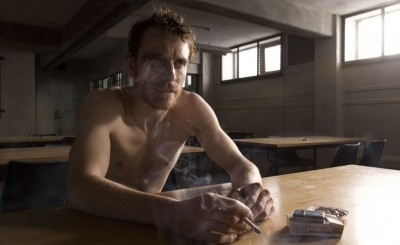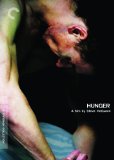| Reviews & Columns |
|
Reviews DVD TV on DVD Blu-ray 4K UHD International DVDs In Theaters Reviews by Studio Video Games Features Collector Series DVDs Easter Egg Database Interviews DVD Talk Radio Feature Articles Columns Anime Talk DVD Savant Horror DVDs The M.O.D. Squad Art House HD Talk Silent DVD
|
DVD Talk Forum |
|
|
| Resources |
|
DVD Price Search Customer Service #'s RCE Info Links |
|
Columns
|
|
|
Hunger (Criterion Collection)

Watching Hunger is a painful and illuminating experience. It cuts to the marrow of a tendentious, charged historical moment via flawless visual storytelling. The film starts out by documenting the effects of external brutality upon a group of jailed IRA soldiers. A long conversation between two key characters serves as a kind of entr'acte, wherein we are privy to the logic behind the inversion of that brutality. The second act allows that inversion to play out through Bobby Sands' conscious decision to subvert the external brutality with self-imposed starvation, a tactic that simultaneously takes him out from beneath the boots of his jailers, while condemning himself to an even harsher fate than that of his fellows. The film's structure is deliberate and purposeful. In telling the story of the Maze and Bobby Sands, the filmmakers have eschewed historical context and political angles in favor of focusing almost exclusively on life inside the prison. It's a narrow way of covering true events, but it also allows the craft of filmmaking to intuitively find the heart of the story without becoming stuck in the minutiae of historical re-creation.
We are only introduced to Sands at the first act's end; the preceding screen time mainly follows Davey (Brian Milligan), a prisoner new to HM Prison Maze in Belfast. He has been imprisoned for six years for crimes that are not revealed to us. His cellmate Gerry (Liam McMahon) has covered their walls with shit, sometimes in elaborate patterns. We go on to learn about life in the Maze through Davey's frightened eyes. The story begins in the midst of the Blanket and No Wash protests (a reaction to the British government having revoked IRA prisoners' political status), during which they refuse to wear uniforms or bathe. Forced haircuts and baths lead to much jailer-on-prisoner violence, with any and all prisoner resistance exponentially increasing its severity. Toward the end of this first act, we are introduced to Bobby Sands (Michael Fassbender). Sands was sentenced to fourteen years in the Maze for possession of a revolver. We first seem him being dragged kicking and screaming into a lavatory where guards hack off his long, filth-encrusted hair and hold him in a bathtub for a cursory scrub.
The aforementioned entr'acte takes place shortly after this. It consists of a long conversation between Sands and his priest (Liam Cunningham), in which Sands announces his intention to go on a hunger strike and the priest tries to dissuade him. It's a very long scene - about 20 minutes, with most of that time devoted to a single still, unbroken shot. The two actors carry it off expertly, although I question the speed of their delivery. Hunger is a slow, steady film and this scene features energetic, play-like performances that feel out of step with the movie's tone. There is much that is impressive about this long, ambitious, emotional sequence, but I can't help feeling that it doesn't live up to its intentions.
The second act exclusively follows Sands' deterioration in unflinchingly graphic detail that avoids seeming gratuitous or exploitative.
Hunger was co-written and directed by Steve McQueen, and was my introduction to his work. Hunger is relentlessly sensory. The visuals consist of formally-composed shots that convey the story in a highly-controlled way. Expository dialogue is virtually nonexistent, with the exception of the entr'acte. The camera is the narrator, and it shows what we need to know about the hideous conditions in the Maze.
One might question the aesthetically-pleasing style of Hunger. Such raw subject matter could have received a grittier, handheld, choppier treatment designed to push our faces into the filth. This, of course, would have also forced an audience to sympathize with the prisoners. (Although Hunger focuses on prisoners' experiences, it also takes time to follow an unnamed prison guard [Stuart Graham], who partakes in violence against prisoners, but appears to know that he's less of a person for it.) I think McQueen's visual choices are mesmerizing and effective. Formal compositions alert us that we are being directed to look at something in particular. Whereas the subjective camera places us in a position that evokes a specific emotional response, formality leaves it up to us to ask why we're seeing a particular image framed in a particular way. Composition is as out of fashion in film as it is in painting, but it's a technique that brings us back to the basic communicative nature of art, and McQueen handles it with care and dexterity.
Images and ideas from Hunger linger persistently. Fassbender's transformation into the starved Sands is alarming. Graham's nearly silent performance as the demoralized guard is also terribly compelling. With bracing focus, McQueen's film studies a particular set of events and human responses to extreme circumstances. As Sands experiences a slow, agonizing death, we are offered a glimpse into the type of rare strength required to rebuke an impenetrable institution of authority.
The DVD
The Package
The Criterion Collection has released Hunger on a single disc inside of a clear keepcase adorned with double-sided cover art. A booklet is included that contains an essay by Chris Darke.
The Video
Hunger is presented in an enhanced 2.35:1 widescreen transfer. The dark visuals are supported by thick blacks and browns. Light is natural or of a type that mimics the institutional fluorescents of the prison. Hunger was shot on film, and the transfer reproduces the bold visuals while maintaining the fine gradations in color, light, and shadow of the source medium.
The Audio
The 5.1 Dolby Digital soundtrack is very quiet most of the time, but explodes to life during scenes of violence and noise. Surrounds are active throughout, with subtle ambient effects consistently present, even in the quietest scenes. It's a very strong track.
The Extras
Criterion has put together a few substantial supplements here that deepen the experience of the film. Steve McQueen (17:52) is an illuminating interview with the filmmaker in which he discusses what propelled him to make the film, and how he approached it technically and thematically. The Making of Hunger (13:24) includes the views of a number of key participants, including McQueen, Cunningham, Fassbender, producer Robin Gutch, co-writer Enda Walsh, and others. An interview with Michael Fassbender (13:39) includes a discussion of the physical challenges associated with his role as Sands. The best and most illuminating single supplement, however, is an episode from the BBC current affairs series, Panorama. Broadcast four months after Sands' death, the episode (titled "The Provos' Last Card?" [45:01]) investigates the roots of the hunger strike, which was still ongoing at the time this was originally aired. Interviewees include Gerry Adams, Ian Paisley, and John Hume. It's an invaluable historical document on its own.
Final Thoughts
Hunger is a brilliant, intense, visceral experience delivered by fearless performers and committed filmmakers. Thoughtfully crafted and showcasing a lucid, elegant technical facility, Steve McQueen's first feature signals a promising career. Highly recommended.
|
| Popular Reviews |
| Sponsored Links |
|
|
| Sponsored Links |
|
|
| Release List | Reviews | Shop | Newsletter | Forum | DVD Giveaways | Blu-Ray | Advertise |
|
Copyright 2024 DVDTalk.com All Rights Reserved. Legal Info, Privacy Policy, Terms of Use,
Manage Preferences,
Your Privacy Choices | |||||||













